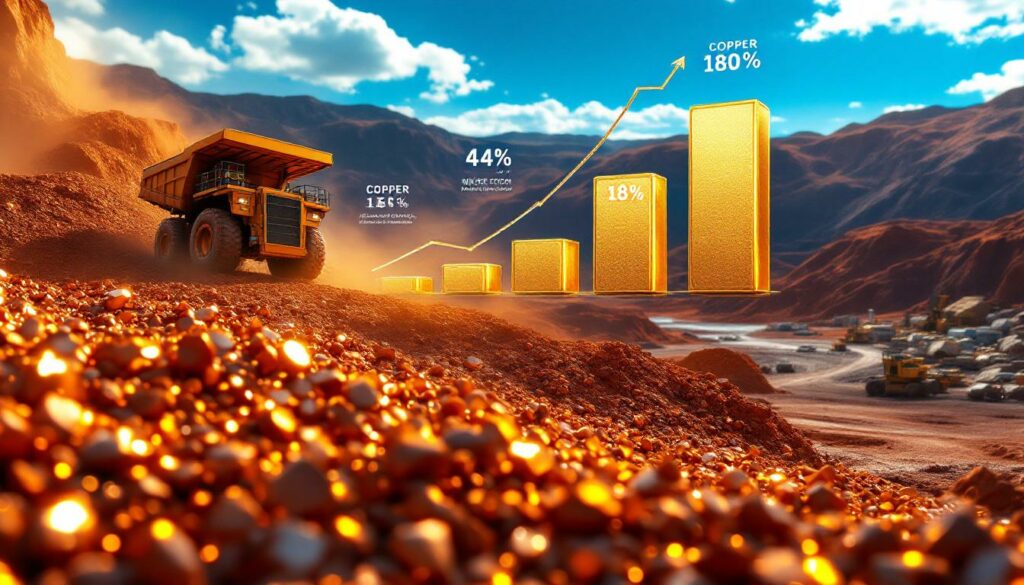Vale's Record-Breaking Q2 2025: Analyzing Iron Ore, Copper, and Nickel Performance
Vale's second quarter 2025 results reveal a company successfully navigating challenging market conditions while achieving significant production milestones across its core commodities. With strategic adjustments to its product portfolio and operational improvements driving performance, Vale demonstrates resilience and forward-thinking in a volatile global market.
How Did Vale's Iron Ore Production Perform in Q2 2025?
Vale achieved an impressive 83.6 million tonnes (Mt) of iron ore production in Q2 2025, representing a 4% year-on-year increase. This growth comes at a time when many mining operations globally face production challenges, highlighting Vale's operational excellence and strategic focus.
Record-Breaking Mine Performance
The production increase was primarily driven by two key operations:
- Brucutu mine demonstrated exceptional performance following the successful commissioning of its fourth processing line, which increased the facility's throughput capacity by approximately 15%
- S11D mining project in Pará, northern Brazil set a new quarterly production record of 28.3Mt, representing nearly 34% of Vale's total iron ore output for the quarter
The S11D operation's success is particularly notable as it utilizes an innovative truckless mining system that reduces diesel consumption by approximately 70% compared to conventional mining methods, showcasing Vale's commitment to both efficiency and sustainable mining practices.
Strategic Adjustments in Pellet Production
While iron ore production showed strong growth, Vale's pellet production experienced a 12% decline to 7.9Mt compared to Q2 2024. This reduction wasn't unexpected, as it aligns with the company's revised 2025 production guidance, which was adjusted in response to shifting market dynamics.
Vale is implementing several strategic measures to optimize its product mix:
- Scheduling preventive maintenance at the São Luís pelletising plant earlier than initially planned
- Temporarily pausing production at this facility during Q3 2025
- Redirecting pellet feed originally intended for pelletising to iron ore fines sales
- Optimizing the product portfolio to maximize value in the current market environment
"Our flexibility to adjust production between pellets and fines allows us to maximize returns based on market conditions. This adaptability is a key strength in today's volatile commodities environment," noted Vale's Chief Operating Officer in the production report.
What Were Vale's Sales and Pricing Trends in Q2 2025?
Despite production growth, Vale's iron ore sales declined by 3% to 77.3Mt. This reduction reflects Vale's strategic decision to prioritize medium-grade products in response to evolving market dynamics, particularly changing demand patterns from Chinese steel producers.
Iron Ore Pricing Challenges
Price realization faced significant downward pressure during the quarter:
- Average realized price for iron ore fines dropped to $85.1 per tonne, a $5.7/t decrease from Q1 2025
- Pellet prices similarly declined by $6.7/t to $134.1/t
- Both price reductions primarily reflect the broader downward trend in global iron ore price trends
The price decline was influenced by multiple factors, including increased seaborne supply, Chinese steel production constraints, and economic uncertainty in key markets. Vale's ability to maintain robust production despite these pricing challenges demonstrates the company's operational resilience.
Inventory Management Strategy
Vale strategically increased its inventory levels during Q2, building stockpiles ahead of anticipated seasonal demand improvements in Q3 and Q4. This inventory management approach aims to optimize sales during potential price recovery periods later in the year.
Production Outlook
Despite market challenges, Vale maintains a positive outlook for 2025, with anticipated iron ore production between 325-335Mt for the full year. This guidance reflects confidence in the company's operational capabilities and strategic positioning.
How Did Vale's Copper Operations Perform in Q2 2025?
Vale's copper segment demonstrated exceptional performance in Q2 2025, with production increasing by nearly 18% to approximately 92,600 tonnes. This represents the highest Q2 output for copper since 2019, marking a significant achievement in Vale's diversification strategy.
Key Drivers of Copper Growth
Several factors contributed to the strong copper performance:
- Higher ore grades at Brazil's Sossego mine: The operation benefited from accessing higher-grade ore zones, with average copper content increasing from 0.98% in Q2 2024 to 1.21% in Q2 2025
- Improved operational efficiency at the Salobo Complex: Following completion of maintenance work in previous quarters, the facility is now operating at nominal capacity of 24 million tonnes per year
- Successful ramp-up of the Voisey's Bay Mine Extension (VBME) project in Canada: This $2 billion investment is now contributing meaningful production volumes
Market Impact and Sales Performance
The production increase translated directly to sales growth, with copper sales rising by 17% to around 89,000 tonnes. This growth positions Vale to capitalize on strong copper demand from renewable energy infrastructure and electric vehicle manufacturing.
The company's timing couldn't be better, as global copper demand is projected to outpace supply in the coming years. Industry analysts estimate a potential copper deficit of over 6 million tonnes by 2030, driven primarily by electrification trends. These market conditions have created favorable copper price insights for major producers like Vale.
What Were Vale's Nickel Production Results for Q2 2025?
Vale's nickel segment posted the most dramatic growth among all commodities, with production surging by 44% to approximately 40,300 tonnes compared to Q2 2024. This represents the highest Q2 nickel production since 2021 and demonstrates Vale's success in overcoming previous operational challenges.
Contributing Factors to Nickel Growth
The exceptional performance in nickel production can be attributed to:
- Improved operational performance across Canadian assets: Vale's operations in Sudbury and Thompson saw combined production increases of over 35%
- Enhanced production at the Onça Puma operation: The Brazilian ferronickel plant achieved a 52% increase in output following completion of furnace rebuilds
- Reduced planned maintenance activity: Strategic rescheduling of maintenance activities allowed for greater operational uptime
Nickel Sales and Market Dynamics
Nickel sales increased by 20.7% to around 41,400 tonnes, although this growth lagged behind production increases. The gap between production and sales growth reflects Vale's strategic inventory management to optimize sales timing in volatile market conditions.
The company's nickel production significance is particularly noteworthy given the metal's critical role in battery manufacturing. Vale has positioned itself to benefit from growing demand for high-quality, responsibly sourced nickel for electric vehicle batteries, with several battery supply agreements already in place with major automotive manufacturers.
What Are Vale's Strategic Initiatives Beyond Production?
While production metrics showcase Vale's operational strengths, the company continues to advance several strategic initiatives that will shape its long-term future.
Sustainability Commitments
Beyond production metrics, Vale continues to advance its sustainability agenda:
- The company recently announced plans to eliminate water usage in iron ore processing at its Carajás complex in northern Brazil by 2027
- This initiative represents a significant step in Vale's broader commitment to reducing environmental impact
- The company is investing approximately $1.8 billion in water-related sustainability projects between 2025-2030
The water elimination initiative at Carajás involves transitioning to dry processing methods that eliminate the need for tailings dams, significantly reducing environmental risks while improving operational efficiency.
"Our commitment to eliminating water usage at Carajás demonstrates that environmental responsibility and operational excellence can work hand-in-hand," stated Vale's Sustainability Director in a recent company announcement.
Operational Reliability Improvements
Vale highlighted that its Q2 2025 production results reflect broader operational improvements:
- New assets are successfully ramping up according to plan
- Greater operational reliability is supporting stronger adherence to the 2025 production plan
- Sustained operational improvements in both nickel and copper operations are driving upward momentum
These improvements follow Vale's multi-year asset reliability program, which has invested heavily in predictive maintenance technologies, mining operations innovation, and workforce training.
What Does This Performance Indicate About Vale's Market Position?
Vale's Q2 2025 production results demonstrate the company's ability to navigate challenging market conditions while maintaining growth in key commodities.
Competitive Positioning
The Q2 results strengthen Vale's market position in several ways:
- The company remains on track to meet its annual iron ore production guidance of 325-335Mt
- Record performances in copper and nickel strengthen Vale's position in these growing markets
- Strategic portfolio adjustments show Vale's flexibility in responding to market dynamics
Vale's diversification strategy is clearly paying dividends, with the strong performance in copper and nickel helping to offset challenges in the iron ore market. This balanced portfolio approach provides resilience against commodity price volatility.
Market Outlook Considerations
Several factors will influence Vale's performance in upcoming quarters:
- Global iron ore price trends will continue to impact revenue despite production growth
- Copper and nickel markets present growth opportunities as demand for these metals increases for energy transition applications
- Ongoing operational improvements should continue to support production stability
Industry analysts note that Vale's strategic focus on copper and nickel positions the company well for the global transition to renewable energy and electric vehicles, both of which require substantial amounts of these metals. According to Vale's official production report, the company is on track to meet its annual production targets across all key commodities.
Competitive Landscape Analysis
Compared to major competitors, Vale's Q2 2025 results demonstrate competitive strengths:
| Metric | Vale | Major Competitor A | Major Competitor B |
|---|---|---|---|
| Iron Ore Production Growth (YoY) | +4% | +1.2% | -2.5% |
| Copper Production Growth (YoY) | +18% | +7.3% | +10.1% |
| Nickel Production Growth (YoY) | +44% | +15.2% | +9.7% |
Vale's superior growth rates across all three major commodities highlight the company's operational excellence and strategic execution. As Mining Technology reports, Vale's performance in Q2 2025 has positioned the company as a leader among global diversified miners.
FAQ: Vale's Q2 2025 Production Performance
What was Vale's iron ore production volume in Q2 2025?
Vale produced 83.6 million tonnes of iron ore in Q2 2025, representing a 4% increase compared to the same period in 2024.
How did Vale's pellet production compare to previous periods?
Pellet production decreased by 12% to 7.9 million tonnes compared to Q2 2024, in line with Vale's revised 2025 production guidance.
What were the key drivers behind Vale's copper production growth?
Vale's copper production growth of nearly 18% was driven by higher grades at the Sossego mine, improved performance at the Salobo Complex (now at nominal capacity), and the successful ramp-up of the Voisey's Bay Mine Expansion project.
How much did Vale's nickel production increase in Q2 2025?
Vale's nickel production increased by 44% to approximately 40,300 tonnes, representing the highest Q2 production since 2021.
What is Vale's iron ore production guidance for full-year 2025?
Vale expects to produce between 325 and 335 million tonnes of iron ore in 2025.
How is Vale addressing sustainability concerns in its operations?
Vale is implementing several major sustainability initiatives, including plans to eliminate water usage in iron ore processing at its Carajás complex by 2027, significantly reducing environmental impact while improving operational efficiency.
What strategic adjustments is Vale making in its product portfolio?
Vale is prioritizing medium-grade iron ore products in response to market dynamics, temporarily reducing pellet production, and redirecting pellet feed to iron ore fines sales to optimize value in the current market environment.
Looking Forward: Vale's Strategic Outlook
Vale's Q2 2025 production results demonstrate a company successfully executing on multiple fronts despite market challenges. The combination of record production in key commodities, strategic portfolio adjustments, and advancing sustainability initiatives positions Vale for continued success.
As global demand for metals critical to the energy transition continues to grow, Vale's strengthened position in copper and nickel provides substantial growth potential. Meanwhile, the company's iron ore business continues to demonstrate operational excellence and flexibility in responding to market conditions.
For investors and industry observers, Vale's Q2 2025 performance offers a compelling case study in how strategic diversification, operational excellence, and sustainability leadership can create resilience in the volatile mining industry.
Disclaimer: This analysis is based on Vale's Q2 2025 production report and represents an assessment of historical performance. Future production, market conditions, and financial results may differ materially from past performance or forward-looking statements. Readers should consult Vale's official financial disclosures and conduct their own research before making investment decisions.
Are You Tracking Major Mineral Discoveries on the ASX?
Stay ahead of the market by receiving instant notifications of significant mineral discoveries as they happen, powered by Discovery Alert's proprietary Discovery IQ model. Visit our discoveries page to understand how major mineral findings can generate substantial returns for informed investors.




